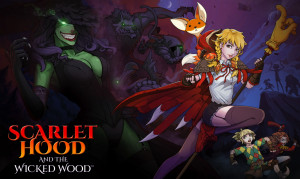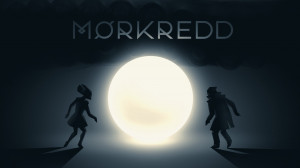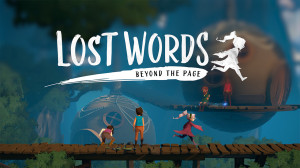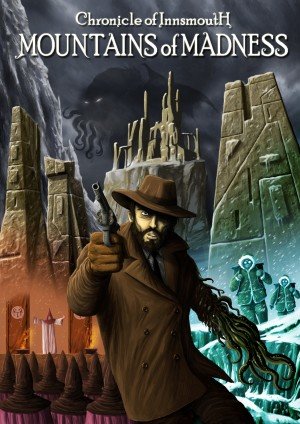Review for Scarlet Hood and the Wicked Wood

Game information
When young Scarlet, lead singer and guitarist of the indie band Foxtrot Bop, gets swept away to the land of Gloam by a tornado, it’s only the start of her troubles. Pursued by the Black Witch and her evil minions, Scarlet experiences her own death. Multiple times. It’s The Wizard of Oz meets Groundhog Day with a touch of Little Red Riding Hood for good measure, in Devespresso Games’ Scarlet Hood and the Wicked Wood. A visual delight, this hand-painted 2D side-scroller keeps its story light and moving briskly along. Its predominantly pattern-matching puzzles and mild action elements may be off-putting to some, but its characters and woodland setting are continually charming throughout.
Events open with Scarlet and the rest of her band heading to a gig being attended by a top talent scout. Scarlet and her friends Sammy, Nick, and Leonard are hoping to make it big and land a recording contract. Things start out well, as the quartet give a fantastic performance to much applause. But it’s all downhill afterwards when Scarlet meets Savannah from Wicked Records, who is only interested in Scarlet as a singer and has no use for her three pals. Complications ensue and Scarlet’s friends abandon her at the side of the road, feeling betrayed that she wouldn’t immediately turn down the offer. Before Scarlet can properly process everything that’s happened, a tornado coalesces and whisks her away.
Scarlet awakens in a cave filled with assorted witch paraphernalia, an excitable Munchkin mechanic named Puck, and a small fox that seems to be guiding her onwards. It’s all a bit much for the befuddled singer, and suddenly becomes even more so when she’s mystically bequeathed with a red hood, Wompin’ Stick, and a single red slipper. As Scarlet meets the rest of Puck’s band of diminutive Munchkins, a performing troupe headed to Castle Royalton for Prince Lir’s coronation and lead by the ridiculously high-crowned, top-hatted Miss Dixie, she learns that’s she’s not just a musician anymore but has assumed the mantle of the Ruby Witch, the old one having not been seen in four years’ time.
Scarlet joins the others, who believe that she, with her magical powers, will be able to protect them from the evil forces of the Black Witch, LeFaba, on their journey through the Wicked Woods. The group set out from their little campsite intent on reaching the coronation in time, but naturally LeFaba has other plans. Ambushing the caravan, she has one of her chief minions, Mama Do, kill Scarlet!
Of course, it’s hard to keep a good witch down. Scarlet reawakens to find herself once more at the caravan’s earlier campsite. Talking to the various Munchkins and a rather put-out fairy named Pippa, who can speak with Scarlet’s furry four-legged familiar Brer Fox, the singer learns that she’s under the influence of a recursion hex. This allows her to survive certain fatal incidents, but at the cost of having to relive the same day over and over again.
It’s here that the game truly begins, with everything that comes before serving to introduce the world, characters, and game controls. The tutorial is much needed, as the controls and interface do take a little getting used to. Designed with a game controller in mind, but also playable via keyboard and mouse, Scarlet can walk left and right or can also run by holding a button. At least, she can run while her stamina lasts. A meter in one corner of the screen dwindles when sprinting or dodging attacks from LeFaba’s minions.
This same area also depicts a series of five hearts, representing Scarlet’s health. The young heroine can be injured by various adversaries that pop up occasionally. If she loses all five hearts, it’s game over – the recursion hex only protects Scarlet from deaths that are important to the story and occur during cutscenes. Dying from avoidable damage requires reloading a previous saved game. While it’s not a fully accessible save system – you’ll have to make use of the various Mystic Totem stone shrines scattered throughout the environment to record your progress – the game supports up to four manual saves, which feels like a luxury in these days of single autosaves.
LeFaba’s dangerous minions come in one of three forms. Dodobos, led by Mama Do, are large buzzard-like creatures that walk around in conquistador armor and swipe at Scarlet with spears and swords. Monkeytas are small winged monkeys that hang out at the top of the screen and shoot darts at fixed points in Scarlet’s path. They are ruled by the blunderbuss-toting Bad Baboo, who is encountered in a cutscene at the end of one of the game’s time loops. By far the most dangerous foe Scarlet encounters is Brer Wolf, a towering muscle-bound beast. He appears in each of the game’s time iterations, usually after Scarlet accomplishes a key objective, and roams the woods searching for the Ruby Witch. If he spots her, he will chase her down and attack her.
With one exception, the enemies in Scarlet Hood are easily evaded. A tap of a button causes Scarlet to do a twirling dodge that carries her past the slow-moving Dodobos and spots the Monkeyta are shooting at (conveniently marked by X’s on the ground). Brer Wolf is another story. Once he arrives on the scene, he can be heard moving somewhere about the game’s various side-scrolling locations. Get too close to him and the chase is on. The problem is that although Brer Wolf’s movements are conveyed in stereo sound, it can still be difficult to tell where he is or whether he’s in the same room as you at all, as his audio carries over from adjacent locations. There’s no visual indication of his position until he appears on-screen, at which point he spots Scarlet and pursues her doggedly.
The only way to escape with Brer Wolf hot on your heels is to run to a scene with some kind of restricted access point, such as a tower door that the wolf is too large to enter or a low tunnel that Scarlet can crawl through but her nemesis can’t. Care must be taken not to exhaust the stamina bar, however, as doing so reduces the heroine’s movement speed to a slow dawdle until enough stamina regenerates over a short period of time for her to run again. Dropping out of a sprint to Scarlet’s normal run speed will allow her to slowly regain some stamina. However, there are better options, especially when the wolf is close.
While Scarlet can’t directly combat the foes she encounters, she can find a selection of consumable medicinal items that help her deal with the effects of being attacked. Different herbs and foodstuffs can restore one or more of the protagonist’s health hearts, or they may regenerate her stamina or lower the rate at which it depletes. Scarlet can carry up to six such salves at a time, displayed in a small track in the bottom right corner of the screen. Fortunately, enemies are not so common that you’ll always be running or dodging for your life. In my entire seven hours of play time, I died but once due to injuries sustained this way and only used a small handful of healing items. The mild action sequences here aren’t really intended to be major obstacles, but rather to add a little spice to the proceedings.
Perhaps “proceedings” is a bit of an inappropriate term to use for Scarlet’s adventure, as she is fated to die numerous times and relive the day’s events in an effort to further her knowledge and assemble help to bypass the various ambushes LeFaba throws at her. All told, Scarlet must find a way to defeat Mama Do, Bad Baboo, and Brer Wolf before dealing with LeFaba herself. Each repeated day, the Ruby Witch gets a little further in accomplishing her goal.
While Scarlet herself finds the process of reliving the same day over and over frustrating and tedious, the game is designed to be anything but. Scarlet, the fairy Pippa, and Brer Fox retain their memory of events from previous time loops, while the members of the Munchkin caravan do not. This leads to some humorous exchanges with the Munchkins, who believe that Scarlet has the ability to read their minds.
Each pass through the loop, Pippa will offer advice on dealing with the next major adversary in the chain that killed Scarlet in the previous loop. This direction takes the singer to various parts of the Wicked Wood to look for a way to defeat whatever foe is causing the current problem. In the introductions to these sections, Pippa always suggest there are three ways to thwart an opponent: find someone or something to help, or discover one of the long-lost Seelie Shrines to, I think, grant more magical powers to Scarlet. Throughout the entire game, however, I only ever succeeded in the first of the three alternatives at any given point: finding someone else who could swoop in to face off against whichever end-of-the-time-loop boss was currently in the way.
I actually didn’t mind having to locate other people to help, because L. Frank Baum’s influences come increasingly into play as Scarlet aids and befriends a collection of colourful characters. There’s Punkin Jack, nee Professor Ichabod Jack, who needs Scarlet to get his essence out of a bottle and into a new head (it makes sense at the time). Then there’s Sir Ulysses Talus, a steampunk robot who requires the construction of a new mechanical heart. And finally there’s Captain Leopold Goldmane, an anthropomorphic pirate lion who jumps in fright at everything and is desperate for a shot of liquid courage. As with the Gale family’s hired hands later representing the Scarecrow, Tin Man, and Lion in the Wizard of Oz movie, Scarlet’s three band member buddies have more than a passing resemblance to this game’s trio of heroes, who passed into Munchkin legend when they disappeared into the Wicked Woods while trying to stop the Black Witch years earlier.
Naturally, helping each of the Oz substitutes isn’t just a straightforward task. Various puzzles are placed in Scarlet’s way, both here and throughout the rest of the game. Some consist of collecting objects that go into Scarlet’s inventory. There’s never any question as to whether you have the right item for a job or not, as the game automatically chooses the appropriate one. All that’s needed is the press of a button to use it on the applicable hotspot when Scarlet draws near. That said, I did have to contend with one puzzle that required moving a heavy statue. I had several things at the time that seemed suitable for the job, especially a shovel whose description specifically stated it was used for “moving heavy objects.” However, none of these items were deemed applicable to the situation. Fortunately, this was the only instance of such inventory limitations I encountered.
With inventory use being so streamlined, the game’s main brainteasers come in different forms of pattern matching. For example, early on Scarlet needs to enter a combination on a numeric keypad, which requires finding a series of numbers in paintings on a nearby wall. Elsewhere, sketches of Dodobos sitting on different nests with different accoutrements correspond to a grid that opens another door. In fact, most of the matching puzzles here involve opening one door or another. There are a few mechanical puzzles too, such as repairing a wheel on the caravan carriage or piecing together Sir Ulysses Talus’s steampunk heart. These are also solved by matching patterns, however, through choosing the pieces mapped out in blueprints.
Later on there are a number of puzzles that require more thought and careful observation. In one such instance, you’ll have to place a series of gears such that no connections will cause them to bind by turning in opposing directions. In another case, you need to construct a security punch card by combining partial templates to form the correct series of holes. As with the pattern puzzles, these are shown up close in first person. While the various interactive bits can be manipulated using a game controller, this is one area where the mouse is definitely the preferred device, as these sequences play out as simple 2D point-and-click puzzles. Fortunately, if you have both options available, alternating between the two control styles can be done simply by switching to the appropriate input device on the fly.
One challenge that must be noted is the presence of a maze, which feels like unnecessary padding. The labyrinth here is straightforward, but even with the aid of Scarlet’s growing magical abilities, which provides on-screen indicators of the path a given character hiding in the maze took, it still takes a fair bit of time to navigate. The quarry being tracked was able to bypass doors and walls that the Ruby Witch cannot, which requires finding a more circuitous route to the target. This maze is traversed in the same side-scrolling manner as other locations, with doorways in the background and foreground causing directional indicators to appear when Scarlet gets close, allowing her to move backwards or forwards as appropriate.
While many of the puzzles Scarlet encounters start to feel similar, the same cannot be said of the locations housing these conundrums. Each part of the woods you visit has its own distinct look and even season. The campsite appears to be set during the heart of summer, but when Scarlet wanders off to find Punkin Jack, she traipses through the oranges, reds, and yellows of autumn leaves. Later, in seeking out Sir Ulysses Talus, she wanders past large, cascading waterfalls with spring flowers sprouting up, while Captain Leopold Goldmane’s area takes place during the winter, with snow covering the ground and white mist floating in the air.
The woodland areas typically consist of several connecting rooms representing paths through the forest. It doesn’t take much searching to find places of interest, such as a mechanical workbench, a hidden cave of oil drums, various underground sites, or the lairs of the Dodobo and Monkeyta. Later on, Scarlet even has the opportunity to search through the gothic rooms of LeFaba’s castle, with their rich tapestries, bubbling potions, and an overlarge Venus flytrap.
Every locale is cleanly hand-drawn, vibrantly coloured, and nicely detailed, making for a very satisfying visual journey. Occasional ambient animations, like rushing waterfalls, swaying plants, and fidgeting Munchkins help to add life to some of the scenes. Parallax scrolling, where multiple background images are layered atop one another and move at different rates, help convey the impression of depth in most areas. Characters too are well depicted in a cute, expressive cartoon style. Most have a variety of still poses and expressions, with Scarlet receiving greater attention and having more fluid animations when moving around the environment. Females are a little on the objectified side, with many a bustier and garter on display and the main character sporting a pair of ripped Daisy Dukes.
The greatest range of character expressions comes in their close-up dialog portraits. These large overlays are presented on either side of the screen, visual novel style, whenever Scarlet is talking to someone. Scarlet alternatively looks pensive, tiredly annoyed, frightened, resolute, or even absolutely joyful with a big goofy grin. The array of facial expressions in others she speaks with is just as impressive. They swap through their still poses based on what they have to say, which is presented in subtitles at the bottom of the screen.
Save for a couple of times during the opening and closing cutscenes, during which Scarlet gets a few lines of spoken dialog with a pronounced southern drawl, there are no voices to be heard. However, there’s a pleasant selection of mindworm, synthesized pop and jazz music throughout. These tracks are all rather lively and are a welcome accompaniment to Scarlet’s travels. My favourite tune plays over the game’s opening menu and I would frequently pause there, both at the start and end of a gaming session, just to listen to it for a few moments. Sound effects fit nicely into the world. While there’s not an extraordinary amount, the likes of the shuffling of Brer Wolf, the swing of a Dodobo’s weapon, and the clinks and clanks associated with assembling machinery are enough to complement the on-screen action.
Scarlet Hood and the Wicked Wood is a colourfully beautiful game with a fun, breezy atmosphere. The eponymous protagonist is an endearing companion with whom to spend the same challenging day over and over again. No mere Dorothy off to see the wizard to have him solve her problems, the young heroine here takes charge of the situation, exploring her magical abilities all while wanting to get home to apologize to her friends. The puzzles could do with a bit more variety though they’re entertaining enough, while the action elements lean to the easy side but still add a nice little adrenalin boost to proceedings. Overall, it’s a welcome new time-looping spin on beloved classic fantasy tales, and for those considering a purchase, it’s worth a greedy cackle as you declare, “I’ll get you, my pretty!”
































